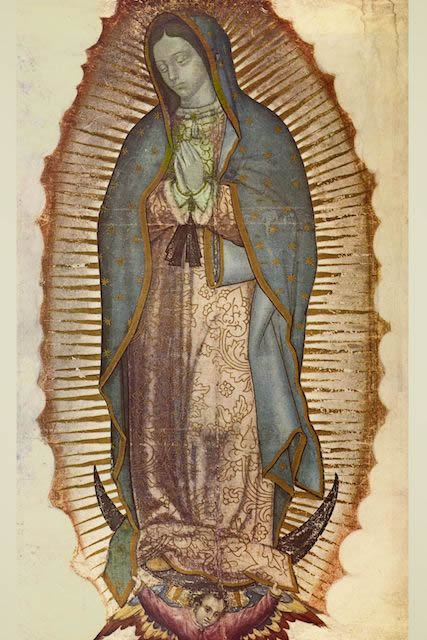
IT is one of the most remarkable ongoing miracles in modern times, and the majority of Catholics are likely unaware of it. Chapter Six in my book, The Final Confrontation, deals with the incredible miracle of the image of Our Lady of Guadalupe, and how it relates to Chapter 12 in the Book of Revelation. Due to widespread myths that have been accepted as facts, however, my original version has been revised to reflect the verified scientific realities surrounding the tilma upon which the image remains as in inexplicable phenomenon. The miracle of the tilma needs no embellishment; it stands on its own as a great "sign of the times."
I have published Chapter Six below for those who already have my book. The Third Printing is now available for those who would like to order additional copies, which includes the information below and any typographical corrections found.
Note: the footnotes below are numbered differently than the printed copy.
CHAPTER SIX: A WOMAN AND A DRAGON
A great sign appeared in the sky, a woman clothed with the sun, with the moon under her feet, and on her head a crown of twelve stars. She was with child and wailed aloud in pain as she labored to give birth. Then another sign appeared in the sky; it was a huge red dragon, with seven heads and ten horns, and on its heads were seven diadems. Its tail swept away a third of the stars in the sky and hurled them down to the earth. (Rev 12:1-4)
IT BEGINS
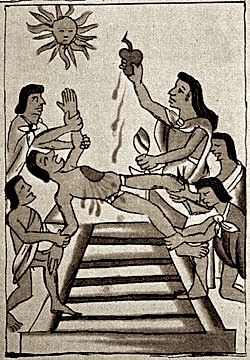 They were one of the bloodiest cultures on earth. It is estimated that the Aztec Indians, in what is known as Mexico today, sacrificed, along with the rest of Mezzo-america, as many as 250,000 lives each year.1 The bloody rituals sometimes included removing the victim’s heart while he was still alive. They worshipped the Serpent-god Quetzalcoatl whom they believed would eventually render all other god’s useless. As you’ll see, this belief was pivotal in the eventual conversion of those peoples.
They were one of the bloodiest cultures on earth. It is estimated that the Aztec Indians, in what is known as Mexico today, sacrificed, along with the rest of Mezzo-america, as many as 250,000 lives each year.1 The bloody rituals sometimes included removing the victim’s heart while he was still alive. They worshipped the Serpent-god Quetzalcoatl whom they believed would eventually render all other god’s useless. As you’ll see, this belief was pivotal in the eventual conversion of those peoples.It was in the midst of this blood-soaked culture of death, in 1531 A.D.,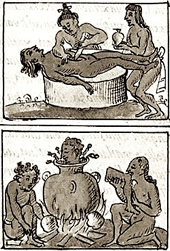 that “the Woman” appeared to a commoner there in what marks the beginning of a great confrontation with the serpent. How and when she appeared is what makes her apparition most significant…
that “the Woman” appeared to a commoner there in what marks the beginning of a great confrontation with the serpent. How and when she appeared is what makes her apparition most significant…
 that “the Woman” appeared to a commoner there in what marks the beginning of a great confrontation with the serpent. How and when she appeared is what makes her apparition most significant…
that “the Woman” appeared to a commoner there in what marks the beginning of a great confrontation with the serpent. How and when she appeared is what makes her apparition most significant… It was at dawn when Our Lady first came to St. Juan Diego as he walked along the countryside. She requested that a church be built on the hill where the apparitions were taking place. St. Juan approached the Bishop with her request, but was asked to return to the Virgin and appeal for a miraculous sign as proof of her appearances. So she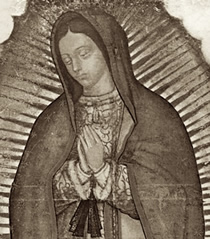 instructed St. Juan to collect flowers from the Hill of Tepeyac and bring them to the Bishop. Even though it was winter, and the ground was rough terrain, he found flowers of every kind blooming there, including Castilian roses, which were native to the Bishop’s homeland in Spain—but not Tepeyac. St. Juan gathered the flowers into his tilma.2 The Blessed Virgin re-arranged them and then sent him on his way. When he unfolded the tilma before the Bishop, the flowers fell to the ground, and suddenly a miraculous image of Our Lady appeared on the cloth.
instructed St. Juan to collect flowers from the Hill of Tepeyac and bring them to the Bishop. Even though it was winter, and the ground was rough terrain, he found flowers of every kind blooming there, including Castilian roses, which were native to the Bishop’s homeland in Spain—but not Tepeyac. St. Juan gathered the flowers into his tilma.2 The Blessed Virgin re-arranged them and then sent him on his way. When he unfolded the tilma before the Bishop, the flowers fell to the ground, and suddenly a miraculous image of Our Lady appeared on the cloth.
 instructed St. Juan to collect flowers from the Hill of Tepeyac and bring them to the Bishop. Even though it was winter, and the ground was rough terrain, he found flowers of every kind blooming there, including Castilian roses, which were native to the Bishop’s homeland in Spain—but not Tepeyac. St. Juan gathered the flowers into his tilma.2 The Blessed Virgin re-arranged them and then sent him on his way. When he unfolded the tilma before the Bishop, the flowers fell to the ground, and suddenly a miraculous image of Our Lady appeared on the cloth.
instructed St. Juan to collect flowers from the Hill of Tepeyac and bring them to the Bishop. Even though it was winter, and the ground was rough terrain, he found flowers of every kind blooming there, including Castilian roses, which were native to the Bishop’s homeland in Spain—but not Tepeyac. St. Juan gathered the flowers into his tilma.2 The Blessed Virgin re-arranged them and then sent him on his way. When he unfolded the tilma before the Bishop, the flowers fell to the ground, and suddenly a miraculous image of Our Lady appeared on the cloth. OUR LADY OF GUADALUPE: A LIVING IMAGE
The actual miracle was so overwhelming that the bishop never contested it. For centuries, it remained the only uncontested miracle by the Church (though in 1666, an investigation was conducted primarily for historical reference.) It is important to pause for a moment to consider the nature of this miraculous event, for it underscores the great significance of this apparition.
This cloth is among the most exceptional ongoing miracles in modern times. What I am about to explain below has been scientifically verified, and amazingly, is known by relatively few in the Church. The fact that technology is only now able, in our times, to discover some of the tilma’s miraculous elements is also significant, as I will explain.
In August of 1954, Dr. Rafael Torija Lavoignet discovered that her eyes demonstrated the Purkinje-Sanson law. That is, they contained three mirror reflections of the same image on the inner and outer cornea and outer lens surface—characteristics belonging to a human eye. This was confirmed again in 1974-75 by Dr. Enrique Graue. In 1985, hair-like images of blood vessels were discovered in the upper eyelids (which were not circulating blood, according to some rumors).
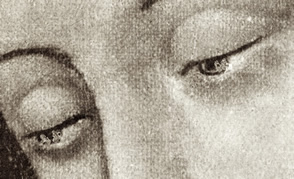 Perhaps most remarkable was the discovery, through digital technology, of human figures in her pupils that no artist could have possibly painted, particularly on such rough fibers. The same scene is reflected in each eye revealing what appears to be the instant that the image appeared on the tilma.
Perhaps most remarkable was the discovery, through digital technology, of human figures in her pupils that no artist could have possibly painted, particularly on such rough fibers. The same scene is reflected in each eye revealing what appears to be the instant that the image appeared on the tilma. It is possible to discern a seated Indian, who is looking up to the heavens; the profile of a balding, elderly man with a white beard, much like the portrait of Bishop Zumárraga, painted by Miguel Cabrera, to depict the miracle; and a younger man, in all probability interpreter Juan González. Also present is an Indian, likely Juan Diego, of striking features, with a beard and mustache, who unfolds his own tilma before the bishop; a woman of dark complexion, possibly a Negro slave who was in the bishop’s service; and a man with Spanish features who looks on pensively, stroking his beard with his hand. —Zenit.Org, January 14th, 2001
The figures are located exactly where they are supposed to be in both eyes, with distortion in the images agreeing with the curvature of a human cornea. It’s as though Our Lady had her picture taken with the tilma acting as a photographic plate, her eyes bearing the scene of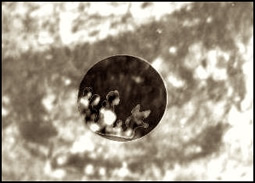 what occurred at the moment the image appeared in front of the Bishop.
what occurred at the moment the image appeared in front of the Bishop.
 what occurred at the moment the image appeared in front of the Bishop.
what occurred at the moment the image appeared in front of the Bishop.Further digital enhancements have found an image, independent of the other, situated in the center of her eyes. It is that of an Indian family made up of a woman, a man and several children. I will discuss the significance of this later on.
The tilma is made of ayate, a coarse fabric woven from ixtle plant fibers. Richard Kuhn, a Nobel Prize winner in chemistry, has found that the original image does not have natural, animal, or mineral colorings. Given that there were no synthetic colorings in 1531, the source of the pigments is inexplicable. Zenit News Agency reports that in 1979, Americans Philip Callahan and Jody B. Smith studied the image using infrared rays and also discovered, to their surprise, that there was no trace of paint or brush strokes, and that the fabric had not been treated with any kind of technique. There is no thickness to the pigmentation, so there is not the usual aspect that we are used to seeing in, say, an oil painting where colors “melt” together. The ixtle fibers are also visible through parts of the image; that is, the holes of the fabric are visible through the pigmentation giving the sense that the image “hovers,” though it is indeed touching the fabric.
Presenting these facts at a Pontifical conference in Rome, a Peruvian environmental systems engineer asked:
[How] it is possible to explain this image and its consistency in time without colors, on a fabric that has not been treated? [How] is it possible that, despite the fact there is no paint, the colors maintain their luminosity and brilliance? —José Aste Tonsmann, Mexican Center of Guadalupan Studies; Rome, January 14th, 2001; Zenit.org
Indeed, the tilma appears to be somewhat indestructible. Ayate cloth has a normal lifespan of no more than 20-50 years. In 1787, Dr. Jose Ignacio Bartolache made two copies of the image, trying to recreate the original as accurately as possible. He placed two of these copies in Tepeyac; one in a building called El Pocito, and the other in the sanctuary of St. Mary of Guadalupe. Neither lasted even ten years, underscoring the astonishing incorruptibility of the original image: it has been over 470 years since Our Lady appeared on St. Juan’s tilma.Furthermore, when consideration is given to the fact that there is no under-drawing, sizing, or over-varnish, and that the weave of the fabric is itself utilized to give the portrait depth, no explanation of the portrait is possible by infrared techniques. It is remarkable that, in over four centuries, there is no fading or cracking of the original figure on any portion of the ayate tilma, which being unsized, should have deteriorated centuries ago. —Dr. Philip C. Callahan, Mary of the Americas, by Christopher Rengers, OFM Cap., New York, St. Pauls, Alba House, 1989, p. 92f.

No comments:
Post a Comment